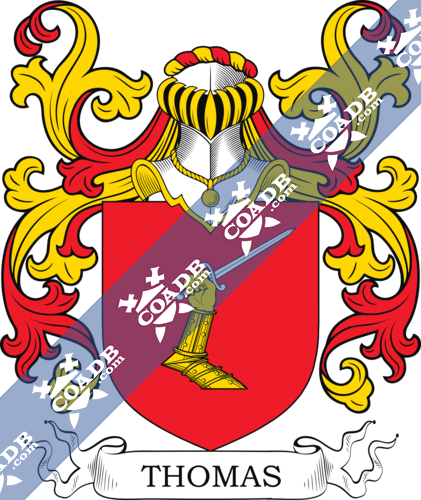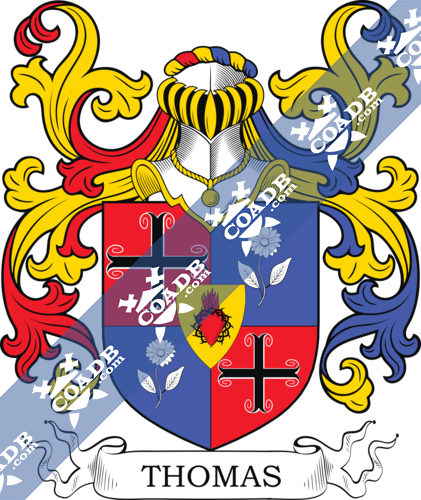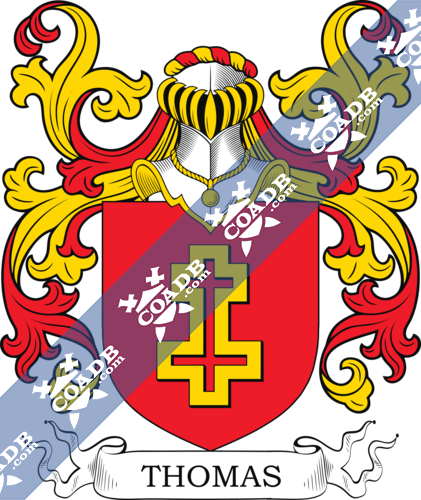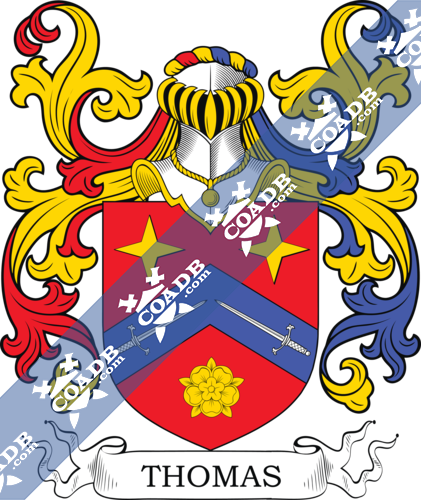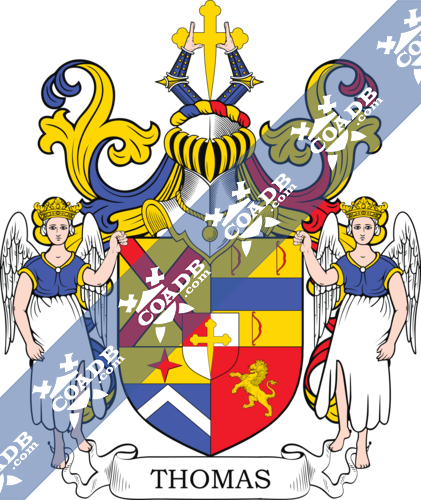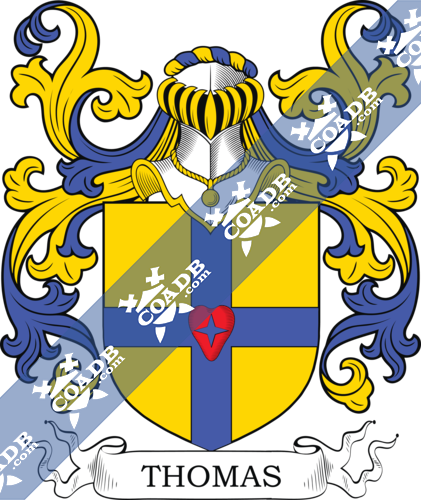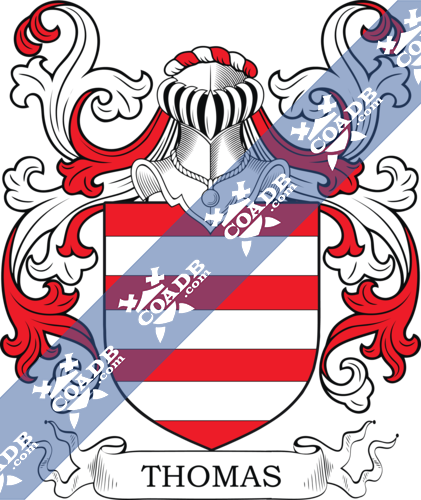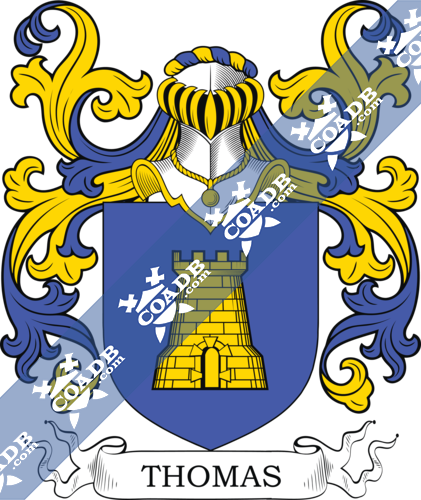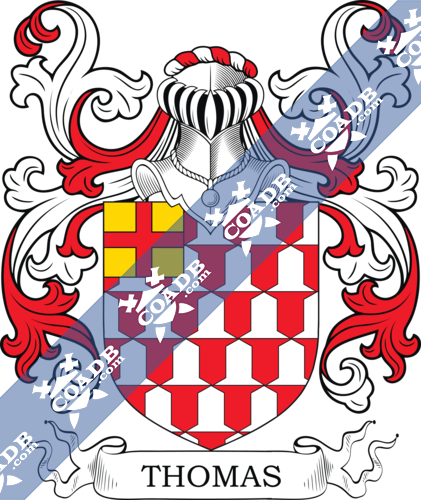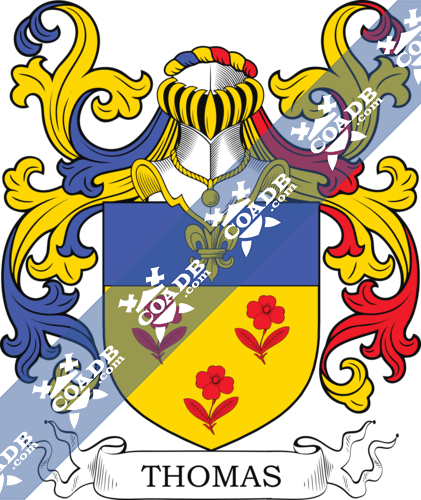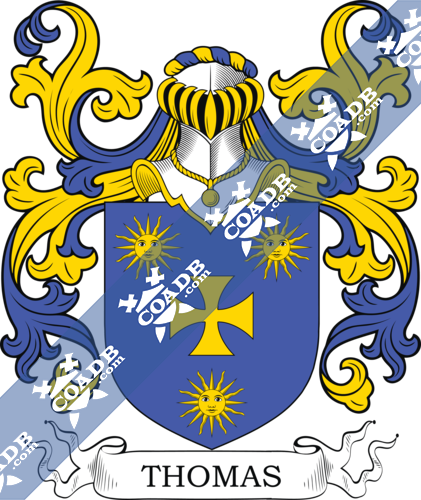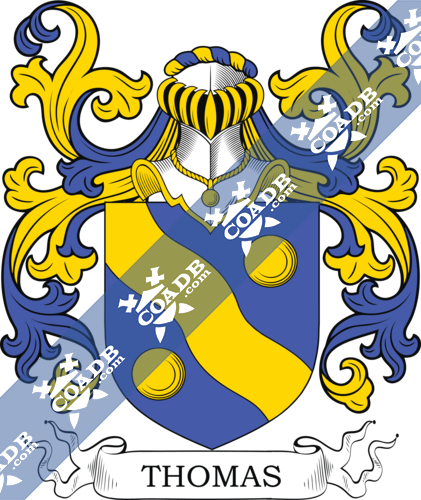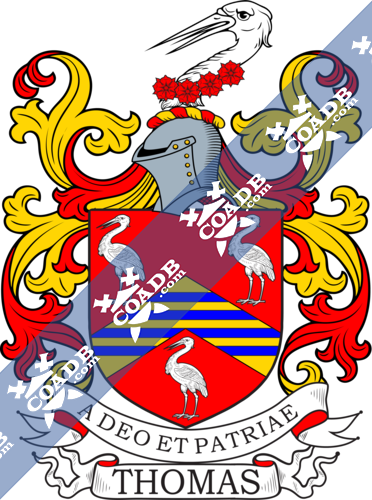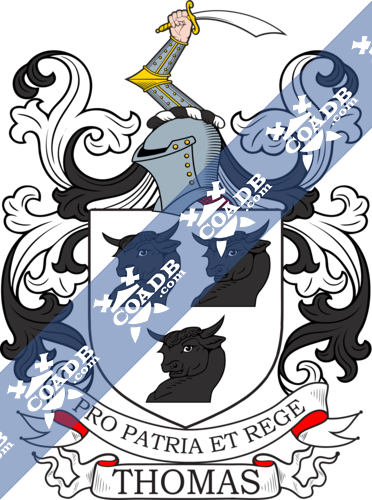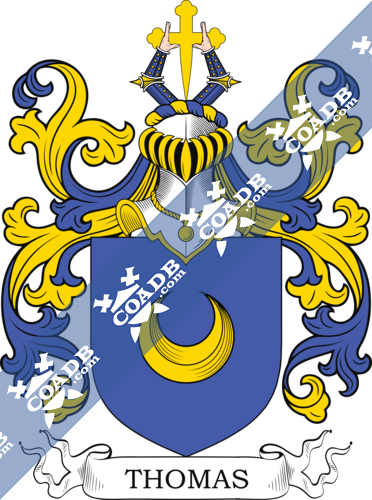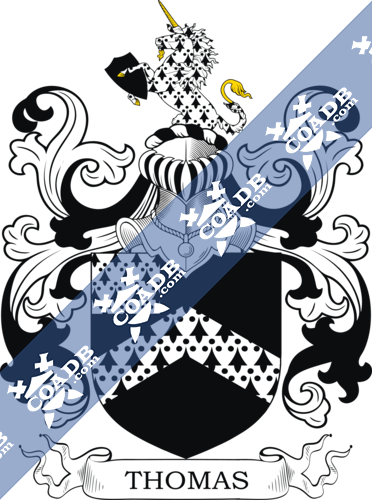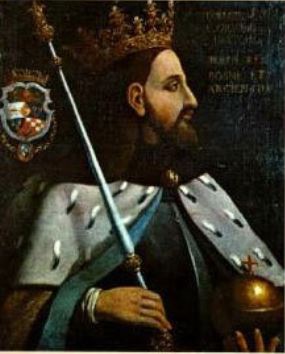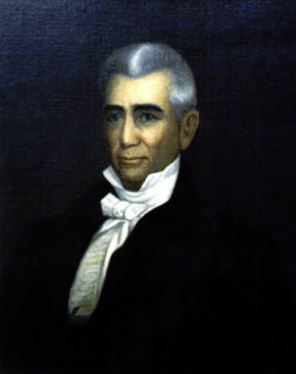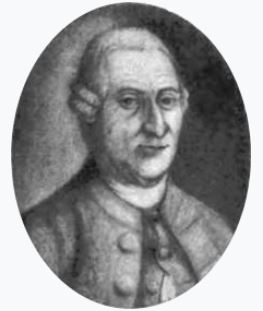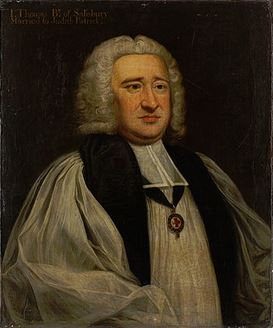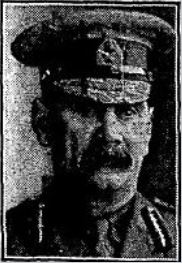Thomas Family Crest, Coat of Arms and Name History

Thomas Coat of Arms Gallery
Don’t know which Coat of Arms is yours?
We can do a genealogical research. Find out the exact history of your family!
Learn MoreBarrett Surname Name Meaning, Origin, History, & Etymology
This is primarily an English, Welsh, French, German, Danish, and Dutch baptismal or patronymic last name meaning the “son of Thomas” or the “son of Thomasine”, deriving from the ancient personal (first) name Thomas. The masculine given name Thomas derives from a Biblical Greek, Aramaic, and Hebrew name meaning “twin”, originally not a given name, but an epithet of a New Testament figure, first applied to Judas Thomas, the second Judas of the Apostles, hence the designation “twin”. St. Thomas the Apostle, one of the 12 Apostles of Jesus Christ in the Christian religion who was born in Galilee in the Roman Empire in the early first century AD) was born with the name Yehuda (Judas or Jude). The names use as a first name started in the early Middle Ages, with the earliest bearers being Thomas the Presbyter (lived in the 600s) and Thomas the Slav (circa 760-823 AD). It became popular in the High Middle Ages in the British Isle, with early bearers such as Thomas Aquinas (1225-1270 AD), the famous Catholic Saint and philosopher. It was one of the most popular names in the Holy Roman Empire, Christendom, and Europe. One source asserts it was not common in Britain until it was brought from France during the Norman Conquest of 1066 AD. The letters th are organic, the initial letter being the a Greek theta. Whereas the French pronunciation was th, the English pronunciation became t. It is interesting to note that the name is used as a first name by Christians in southern India, as well as a surname of for southern Indians who came to the United States.
The 1946 book, The Surnames of Scotland, by George Fraser Black, states the following: “In Gaelic it assumes the forms Tómar Támhus, hence the Gaelic patronymics Mactavish, Maccombie, and Macomie”. In Wales, the name was Ap Thomas, meaning the son of Thomas. In Wales, the family first became established in Breconshire and claims descent from Owen Glendower, Lord of Glyndwyrdwy, Prince of South Wales, who lived from about 1359-1415 AD. Using wikitree.com, if it is to be trusted as accurate, one can trace the lineage back to King Beli Mawr “The Great” of the Britons who was born in 130 AD. About 42 sons down the Thomas family tree came one Thomas ap Llewelyn, Lord of South Wales, who was born in Wales in 1299 AD. In Germany, the name was first located in Bavaria during medieval times. In England, the name was first established in Lincolnshire, Hamptonshire, and Gloucestershire. A one Thomas of Bayeux, the Bishop of Worcester and Archbishop of York, was documented as a land owner in the Domesday Book of 1086 AD, a survey of England and Wales dictated by William the Conqueror.
Spelling Variations
Some spelling variants, names with similar etymologies, or foreign equivalents, include Thoames, Thoumas, Thoms, Tomas, Thommas, Thomass, Thumm, Thoma, Thome, MacThomas, FitzThomas, Tommasi (Italian), Thom (German), Tomasschek (Slavic), Tomich/Khomich (Belorussian), Fominov (Russian), Thomassson (Swedish), and about 150 others.
Popularity & Geographic Distribution
The last name Thomas ranks 292nd in popularity in the United Status as of the 2000 Census. The name ranks particularly high in the following four states: Pennsylvania, Alabama, Louisiana, and Maryland. The surname Thomas frequency/commonness ranks as follows in the British Isles: England (11th), Scotland (99th), Wales (4th), Ireland (403rd) and Northern Ireland (260th). In England, it ranks highest in counties Cornwall and Gloucestershire. In Scotland, the surname ranks highest in Lanarkshire. In Wales, it ranks highest in county Pembrokeshire, followed closely by several others. In Ireland, it ranks highest in county Donegal. In Northern Ireland, it ranks highest in Antrim. The name is also present throughout the remainder English speaking world: Canada (43rd), New Zealand (22nd), Australia (13th), and South Africa (117th). It also is the 8th most popular surname in France. The 1890 book Homes of Family Names by H.B. Guppy, states the following in regard to this surname: “The great home of this name is in Wales, more especially in South Wales, whence the name has spread in numbers into the adjacent English county of Monmouthshire, and to a less extent into Herefordshire and Shropshire. In the English counties forming the next line, it has, if we exclude Gloucestershire, obtained but little hold. Its further advance into England has been on a small scale, and it is probable that its isolated occurrence in the distant counties of Essex, Yorkshire, etc., may be explained on independent grounds. It has, however, a secondary but evidently an original home in Cornwall, where the name abounds”.
Early Bearers of the Surname
One of the earliest recorded bearers was Henneko Thom, a citizen of Hamburg, Germany in the year 1252 AD. The Hundred Rolls of 1273 AD, a census of Wales and England, known in Latin as Rotuli Hundredorum lists three bearers of this surname: Roger filius (son of) Thomas (Cambridge), Richard Thomas (Suffolk), and Walter Thomas (Wiltshire). A one Richard Thome was recorded in York, England in 1293 AD. The Hundred Rolls of 1301 list one Walter Thomas of Warwickshire. A one Dieter Thumm was documented as living in Wolfschlugen, German in 1327 AD. Kirby’s Quest records one William Thomas in county Somerset in 1327 AD. The Poll Tax of Yorkshire in 1379 AD lists two bearers of this last name: Adam Thomasson and Johannes Thomasson.
Early marriages involving this surname include Alyce Thomas to Thomas Bryse at St. Michael, Cornhill, London in 1582, Anne Thomasyne to John Thorne in London, and Nancy Thomason to Thomas Wyatt at St. George’s Hanover Square in London in 1801, and John Baptiste Thomesin to Jane Prin in St. George’s Hanover Square in 1806.
Thomas Family Tree & Thomas Genealogy
The following is a discussion of nine different noble, royal, landed, or aristocratic families bearing this last name.
Thomas of Llannon
The surname of this branch of the Thomas family tree was originally Treherne. A one Treherne Thomas owned an estate named Llettymawr in Llannon, county Carmarthen, Wales in 1579. He was had a son named Rees Treherne of Llerrymawr, who in 1610, married Helen John of Glamorganshire, and was succeeded by their son Thomas. This Thomas Rees Treherne was an Esquire of Llettymawr who was born in 1612, who married Margaret Bowen of Marchoglwyn, Llannon, and had a son and successor with her named Rees. His son Rees Thomas was an Esquire of Llettymawr who married Sarah Powell of Llalnelly, Carmarthenshire Wales, and had issue with her. His son, also named Rees Thomas, was born in 1680. In 1790, he married Mary, daughter of William King, of Mansaint, near Kidwelly, and had the following issue with her: Rees (of Llettymawr, born 1710), David (of Llwydcoed, Llannon, married Deborah Rees of Brynynyd, and had issue with her named John and Anne Davies), Morgan (see below), and Elizabeth (married David Davies of Swansea). His son Morgan Thomas was an Esquire of Llettymawr who was born in 1726. In 1768, he married Frances, daughter and heiress of Henry Goring of Frodley Hall, county Stafford and Sarah Gilbert. He died in 1800 and was succeeded by his son Rees Goring Thomas, an Esquire of Llannon, county Carmarthen, Wales, and of Tooting Graveney, county Surrey. In 1799, he married Sarah, daughter of Richard Hovell of Norfolk, and had the following children with her: Rees Goring (his heir), Morgan (Justice of the Peace and Deputy Lieutenant for Sussex and a Member of Parliament, married Louisa Frances Dalrymple, had issue named Morgan, Goring Apsley, Georginia, Emily Louisa, and Mary Florence), George Treherne (in 1846 married Baroness Frederica Hildbrandy and had a daughter with her named Ferdinandina Frederica Georgiana Caroline who married Count Theobald Butler of Bavaria, later married again and had a son named Hugo), and Sarah Frances (married William Henry Pattison of Lincoln’s Inn of Witham). He died in 1821 and was succeeded by his son Rees. Rees was an Esquire of Gelly Werner who was a Justice of the Peace and Deputy Lieutenant, and High Sheriff born in 1801. In 1824, he married Caroline, daughter of William Esdaile, and fathered the following children with her: Rees Goring (of Llannon), William Esdaile (officer in the Army, married and had issue), Morgan Trehearn (born 1830), Morgan (born 1831), George Gilbert Trehearn (married Elizabeth Gape of St. Michael’s and St. Alban’s, had two daughters), Caroline Sarah (married Charles, Count Althann of Militschowes, Bohemia, Grandee of Spain, and had issue named Robert and Constance), Louisa Frances (died at Nice in 1871), and Sarah Frances (married Morgan Jones of Penylan, had issue). His son Rees-Goring Thomas was an Esquire of Llannon, county Carmarthen, a Justice of the Peace and Deputy Lieutenant born in 1824. In 1851, he married Emily, daughter of the Nevill family of Llangenneth Park, and had two issue with her as follows: Rhys Goridng (1864) and Elinor Anne Goring. The Thomas Coat of Arms (erroneously called the Thomas Family Crest by those unfamiliar with heraldry and genealogy) as follows: Gules, on a chevron or, between three herons argent, four barrulets azure. Crest: A heron’s head erased argent gorged with a garland of roses gules. Motto: Deo et patre. They were seated at Llannon, county Carmarthen, Wales, and Tooting Lodge, Sussex, England in modern day United Kingdom.
Thomas of Ratton
The lineage of this family traces back to Thomas Freeman, Esquire of Antigua, son of Arthur of London. He had four sons: Arthur, Robert, Thomas, Byam. He also had four daughters, who married into the Warner, Kirwan, Philips, and Talbot families. His eldest son, Arthur Freeman, was an Esquire of Lincoln’s Inn Fields, or St. Clement Danes, and was the father of Thomas. This son Thomas Freeman was an Esquire of Antigua who had several issue. His eldest son was Arthur Freeman, an Esquire of Antigua, who in 1765, married Margaret, daughter of Sir George Thomas of Yapton, and had five issue with her as follows: Inigo (of Ratton and Yapton), George Thomas (Lieutenant Colonel 11th Light Dragoons), Margaret, Melesina Warburton (married Nathaneil Bayley of Bath), and Lydia Frances (married John Leonard Knapp of Alveston). His eldest of Inigo Thomas, Esquire of Ratton and Yapton, Justice of Peace and Deputy Lieutenant, was born in 1767, and he succeeded his maternal uncle, Sir William Thomas Baronet of Yapton, 1777, and in compliance with his will, assumed the last name of Thomas in place of his patronymic, Freeman, by royal license in 1786. In 1707, he first married Charlotte, daughter of Henry Peirse of Bedale, and with her had daughters named Charlotte and Georgiana (married William Battie Wrightson of Cushworth). In 1803, he secondly married Frances Anne Brodrick, daughter of George, Viscount Middleton, and had nine children with her as follows: Freeman (his heir), William Brodwick, Reverend Arthur (married Julia Skrine of Cambridge, had issue), Henry John (Lieutenant-Colonel of the Royal Army), Charles Edward, Frances, Mary, Albinia, and Louisa (married Arthur John Knapp of Flifton). He was succeeded by his son, Freeman Thomas, and Esquire of Ratton and Yapton who was born in 1808. He was a Lieutenant in the 8th Hussars. In 1836, he married Amelia, daughter of Colonel Thomas Frederick, and had seven children with her as follows: George Freeman, Freeman Frederick, Alan Brodrick, Charles Inigo, Arthur Goring, Florence Emily, and Isabella Mary (married Reverend John Goring of Wiston Park, Sussex, England). His son Thomas Freeman Thomas was an Esquire of Ratton and Yapton, Justice of the Peace, and member of the Rifle Brigade who was born in 1838. In 1863, he married Mabel, daughter of H.B.W Brand, a Member of Parliament of Glynde, Sussex, Speaker of the House of Commons, and had three issue with her: Freeman (see below), Florence, Margaret Georgiana, and Helen. He died in 1868. His son Freeman Thomas was an Esquire of Ratton and Yapton, Sussex, who was born in 1866. He succeeded his father two years later in 1868. The Thomas Coat of Arms (mistakenly called the Thomas Family Shield) has the following heraldic blazon: Argent, three lions rampant gules a chief azure. Crest: A demi-lion rampant gules, on the shoulder an ermine spot argent. They were seated at Ratton, Willingdon, near Eastbourne, Sussex.
Thomas of Ystrad Mynach
The Thomas genealogy begins with David ap Llewelyn, from whom descended Rhys ap Thomas of Llanbradach, Wales. Rhys married Elizabeth, daughter of Richard Carne of Nash, and had a son with her named John. This John Thomas of Llanbradach, married Mary, daughter of Edward Morgan of Bedwelty and Penllwyn Garth, having issue with her. Their eldest son was William Thomas, Esquire of Llanbradaech, who married Joan, daughter and heir of Lewis Llewellyn (10th Lord of Rydlaver) and Jane Mathew of Sweldon, and had issue with her. His eldest son was also named William. This son William was an Esquire of Llanbradach, who married Dorothy, daughter of Sir John, and had issue with her. His eldest son was also named William. This son William Thomas, Esq. of Llanbradach first married Mary, daughter of Anthony Mathew of Roath, in 1693, and had a son with her named Thomas. He secondly married Joan, daughter of Thomas Morgan of Machen, and had issue with her as follows: William, Elizabeth (married Gabriel Thomas of Wauntreoda), Joan (married Thomas Lewis of St. Nicholas), and Jane (married Howel Mathew, had children). His son and heir was Thomas Thomas, an Esquire of Lalanbradach and High Sheriff who married Mary, daughter of James Heriot of London, and had a son with her. This son was James. James died without posterity in 1731 and was succeeded by his uncle William. William married a daughter of Joshua Robotham of Croes and had two children with her: Thomas and Joan (married Evan Jones of Llanwonno). His son and heir was Thomas Thomas, Esq. of Tredornen and later Llanbradach. He married a daughter of Anthony Williams of Penalta in Gelligaer, and had two sons with her. His eldest son, William Thomas, was an Esquire of Llanbradach, Wales, in 1773. He died without posterity in 1781 and was succeeded by his brother Thomas. This Thomas Thomas was an Esquire of Llanbradach who married Catherine, daughter of William Griffiths of Gellifindiglad, and had children with her as follows: William (fought in the Battle of Alexandria), Thomas (married Bridget Gwynne, had daughter named Clara who married Henry Thomas of Llwyn Madoc), and Reverend George (of Ystrad-y-Mynach, married Elixa, daughter of William Crawshay of Cyfarthfa, had issue named George William Griffith, Jane, Eliza, and Katherine). George William Griffith, Esquire of Ystrad Mynach of Glamorgan, who married Ellen, daughter of Robert William Kennard, and had four issue with her: George, Edward Llewelyn, Ellen, and Catherine. This family was seated at Ystrad Mynach, county Glamorgan, Wales, Great Britain, modern day United Kingdom.
Thomas of Llwyn Madoc
This branch of the Thomas family tree descends directly from Elystan Glodrydd, Prince of Fferllys (died circa 1010 AD), and has been seated (held lands and titles) at Llwyn Madoc for several hundred years. A one Evan Thomas, Esquire of Llwyn Madoc, first married, Miss Walter of Clyn, county Radnor, and second Miss Jones, of Crebath, county Brecon. He had two sons with the first wife, named Henry and Thomas. His son Henry Thomas was an Esquire of Llwyn Madoc, who married Martha, daughter of Morgan Gwynne of Brynairon, and had three issue with her: Mary, Jane, and Evan. His son Evan Thomas was an Esquire of Llwyn Madoc and of Sully, county Glamorgan, Wales, in 1807, married Alicia, daughter of Charles Ranken of Richmond Lodge, Belfast, and had the following children with her: Henry (his heir), Charles Evans (of Cranmer, Mitcham, married Caroline Pearson and had issue named Algernon Evan, Edmund Lyons Evan, Llewellyn Evan, Owen Grant Evan, Hugh Evan, Charles Henry Evan, Bartle Evan, Emily Lilian Evan, Catherine Evan, and Cara Mary Evan), Mary, Alicia (married Robert Oliver Jones of Fonmon Castle), Clara Jane, Elizabeth , Anna (married John Coke Fowler), and Emily Martha. He died in 1832 and was succeeded by his eldest son Henry. This Henry Thomas was an Esquire of Llwn Madoc and Pencerrig, who was Justice of the Peace and Deputy Lieutenant, born in 1707. In September of 1835, he married Clara, only surviving child of Thomas Thomas of Llanbradach, and had two issue with her: Evan Llewellyn (his heir) and Clara (successor to her brother). He died in 1863 and was succeeded by his son Evan. Evan was an Esquire of Llwyn Madoc, Penceriff and Llanbradach, Justice and Peace and Deputy Lieutenant, born 1839, and died in 1864. Clara Thomas of Llwyn Madoc, county Brecon, Pencerrig, county Radnor, and Llanbradach, county Glamorgan, Wales succeeded his brother in 1864. This family was armigerous with the following blazon: Argent, on a chevron engrailed azure two griffins recontrant combatant of the field, gorged with two bars gules, on a chief of the second three cinquefoils pierced or. Crest: Out of a ducal coronet or, a demi-seahorse salient sable maned gold. They were seated at Llywn Madoc, county Brecon and at Pencerrg, county Radnor, Wales.
Thomas of Welfield House
This branch of the family tree claims to be a younger branch of the ancient Thomases of Llywn Madoc previously discussed in the above paragraphs, descending from the younger lines of the House of Elystan Glodrydd, Prince of Ferlys. A one Edward Thomas, Esquire, married Catherine Davis, of Saryn-y-Gyfin, county Carmarthen, and had sons with her named Edward and David (Justice of the Peace and Deputy Lieutenant for counties Brecon and Radnor, Wales, and was Esquire to Lord Keith). The elder son, Edward Thomas, was an Esquire and Justice of the Peace. He first married Letita Price, of Mais-y-ron, and secondly Anne, daughter of Peter Jones of Degoedy, county Carmarthen, and had a daughter named Anne (married D. Pritchard) and a son named David. This son, David Thomas was an Esquire, Justice of the Peace, and Deputy Lieutenant for counties Brecon and Radnor, who inherited the mansion of Wifield and the estates of Radnorshire from his uncle David. He also served as a High Sheriff in 1829. In 1807, he married Catherine, daughter of William Jones of Ystrad Walter, county Carmarthen, and had issue with her as follows: Edward David, David (married Julia Sophia Batt of Brecon in 1839, had 12 children), Reverend William Jones (of Llan Thomas, Hay, South Wales, Justice of the Peace, Vicar of Llanigon, married Anne Elizabeth Jones of Hereford, had issue named William Jones, John David Cove, Henry Evans Pateshall, Edward Lechmere, Nicholas Charles Scudamore, Walter Sandys, Mary Elizabeth, Grace Catharine Anne, Charlotte Alice, Edith Burnam, and Francis Eleanor Jane), Evan Pateshall (of Allensmore, Member of Parliament, married Anne Elizabeth Lechmere), Catherine (married Revered Essex Holcombe of Cocheston), Anne (married John Jones of Blaenos), and Mary Alicia. He died in 1830. His son Thomas Edward David was an Esquire of Welfield House, county Radnor, Justice of the Peace, Deputy Lieutenant, and High Sheriff who born in 1808. In 1837, he married Arabella Emma, daughter and co-heir of John Samuel Gowland, of Cagebrook and Amelia Ann Price, and had the following children with her: Edward David (married Caroline Louisa, daughter of C.W. Greenly of Titley Curt, had son named Edward Aubrey), Evan Aubrey (married Captain 7th Dragoon Guards), Francis Gowland, Arabella Katherine Alicia, Amelia Anne Mary, and Rosamira Annabette. The Thomas Coat of Arms (erroneously called the Thomas Family Crest or Thomas Family Shield) is blazoned in the European art of heraldry as follows: Per pale argent and gules, on a chevron engrailed two griffins passant combatant counterchanged a chief wavy azure charged with three cinquefoils argent. Crest: Out of a mural crown argent a demi-sea-horse gules crined or, charged on the shoulder with a cinquefoil argent, and in the paws and anchor erect sable resting on the mural crown. Motto: I Dduw b’or diolch. They were seated at Welfield House, Builth, county Brecon, modern day United Kingdom.
Thomas of Garreglwyd
Sir Robert John Thomas, 1st Baronet, of Garreglwyd, county Anglesey, Wales was a ship and insurance dealer by trade who was born in 1873, son of William Thomas of Bootle. He was a High Sheriff in 1918 and a Member of Parliament for Wrexham and Angelesey. He was created a Baronet in July of 1918. In 1908, he married Maria Rose, daughter of Arthur Burrows, of Shanghai, and had four issues with her: William Eustace Rhyddlad (married Molly McGeachin in 1947), Robert Freeman (Colonel, married Marica Lucas in 1947), Audrey (married Cecil Owen of Anglesey and Antwerp, had issue), and Margaret Rosemary. The Thomas Coat of Arms is blazoned as follows: Per pale gules and azure, on a chevron argent, between in dexter chief a swore scattering seed and in sinister chief an eagle displayed both or, and in base a garb of the last, three fleurs-de-lis sable. Crest: On the waves of the sea proper, between two anchors sable, a ship in full sail, also proper. Motto: Fac recte et nil time. They family resided at Garreglwyd, Holyhead, Anglesey, Wales.
Thomas of Wenvoe
Sir Godfrey John Vignoles Thomas, 10th Baronet, was born in 1889 and succeeded his father in 1919. He was the Private Secretary to The Prince of Wales, and the Assistance Private Secretary to King Edward VIII of England. He was educated at Harrow and was an Officer of Legion of Honour of France. In 1924, he married Diana Mary Katharine, daughter of Benedict George Hoskyns, and had issue with her as follows: Godfrey Michael David. The lineage or ancestry of this family traces back to Edmond Thomas of Wenvoe, county Glamorgan, who was High Sheriff there in 1626. He had a daughter named Maria (married George Kemeys) with his first wife. He then married Frances, daughter of George Catchmay of Bigswear in St. Briavel’s, and had two issue with her: William and James. The elder son, William Thomas, was born in 1611, and he married Jane, daughter of Sir John Stradling of St. Donats Castle, and had children with her including Edmond and Elizabeth (eventual heiress discusses below). He died in 1636 and was succeeded by his son, Edmond Thomas, of Wenvoe, a Member of Parliament for county Glamorgan, Wales, who was born in 1633. He married Elizabeth, daughter of Sir Lewis Morgan, and had three children with her as follows: William, Elizabeth (William Chayne), and Frances. He second married Mary Lewis of Penmark. He died in 1677. He was succeeded by his only son William. This William married the Honorable Mary Wharton, daughter and eventual co-heir of 4th Lord Wharton, and by her, had issue a daughter and son. His only son was Sir Edmond Thomas, Knight, of Wenvoe and Ruperra, succeeded his grandfather in 1677 and Knighted at Bristol in 1686. He died in 1692 and was succeeded by his sister, Anne. This Anne was born in 1675 and died in 1694, whereupon the estates devolved upon her great-aunt, Elizabeth. This Elizabeth Thomas of Wenvoe was born around 1630, daughter of William Thomas, who first married Edward Ludlow, Parliamentary General, in 1650. She secondly married, in 1694, Sir John Thomas, 1st Baronet, Sheriff of Gloucester 1699, son of William Thomas, who was created a Baronet on Christmas 1694. He died in 1702 or 1703 and was succeeded by his brother, Sir Edmond Thomas, 2nd Baronet, who was born in 1667. In 1711, he married Mary, daughter of Right Honorable John Howe of Stowell, county Gloucester, Paymaster of the Forces, and by her, had three children: Sir Edmond (3rd Baronet), John (General officer in the Army, married Sophia, daughter of 1st Earl of Albemarle, had issue including Colonel Charles Nassau). He died in 1723 and was succeeded by his eldest son Edmond. Sir Edmond Thomas, 3rd Baronet, Member of Parliament, county Wilts, was born in 1712, and in 1740, married Abigail, daughter of Sir Thomas Webster, and had three issue with her as follows: Sir Edmond (4th Baronet), Frederick (officer in the guards, died in a duel with Cosmo Gordon), and Sir John (5th Baronet). He died in 1767 and was succeeded by his son Edmond, 4th Baronet. Edmond died in 1789 and was succeeded by his brother, Sir John Thomas, 5th Baronet, who was born in 1749. In 1782, he married Mary, daughter of John Parker, of Hasfield Court, county Gloucester, and two sons with her: Sir John Godfrey (6th Baronet) and Frederick Jennings (Rear Admiral in the Royal Navy, married Susannah Atherley of Southampton, had issue named Frederick, Sir John Wellesley, Barclay, and Mary). He died in 1828 and was succeeded by his son, Reverend Sir John Godfrey Thomas, 6th Baronet, Vicar of Wartling and Bodiam, Sussex, born 1784. In 1808, John married Frances, daughter of Stephen Ram of Ramsfort, county Wexford, and had three daughters with her and one son, Sir Edmond Stephen (7th Baronet). In 1817, he secondly married Elizabeth Anne, daughter of Reverend Vignoles of Cornahir, and had the following issue with her: Sir Godfrey John (8th Baronet), John (married Katherine Elizabeth Bacon), Charles (Lieutenant 54th Bengal Infantry, married Mary Olive Welch of Hailsham, had daughters named Mary Amy and Julia Fanny), Eliza Julia (married Reverend Gilbert Heathcote of Colernc, Wilts), Julia (married Reverend Henry Berens Pratt and later William Kerstenman, died in Canada, had issue), Caroline Margaret (married Ormus Biddulph), and Paulina (Hebert Mascall Curteis of Windmill Hill). He died in 1895. He died in 1841 and was succeeded by his eldest son. Sir Edmond Stephen Thomas, 7th Baronet, Major in the Army, who was born in 1810. He died in 1852 and was succeeded by his half-brother, Sir Godfrey John Thomas, 8tyh Baronet, born in 1824. In 1853, Sir Godfrey married Emily, daughter of William Chambers of Bicknor, and had children, including: Sir Gofrey Vignoles (9th Baronet), Edmond Herbert (married Agnes Marion Squarey of the Moot, Donwton), and Georgina Sophia. He died in 1861 and was succeeded by his eldest son, Godfrey. This Sir Godfrey Vignoles Thomas, 9th Baronet, was a Deputy Lieutenant of county Essex and a Colonel in the Royal Army, as well as a Brigadier General who served in Afghanistan, Egypt, Sudan, the South African War, and World War I. He was born in 1856, and in 1887, he married Mary Frances Isabelle, daughter of Mary Frances Isabelle, daughter of Charles Oppenheim, of Great Cumberland Place, and had issue with her, including Sir Godfrey John Vignoles, the 10th Baronet, discussed at the beginning of this paragraph. The family coat of arms is blazoned in heraldry as follows: Sable, a chevron and canton ermine. Crest: A demi-unicorn ermine, armed, crined, and unglued or, supporting a shield sable. Motto: Virtus invicta gloriosa. This family had residences at Wynters, Harlow, Essex, and Marlborough Hate, St. James Place, in England, Great Britain, or modern day United Kingdom.
Thomas of Yapton
The lineage or ancestry of this branch of the family traces back to Sir George Thomas, 1st Baronet, of Yapton Place, Sussex, England, who was the son of Colonel George Thomas. He was the Governor of Pennsylvania from 1738-1747 and of the Leeward Islands from 1753-1766. He was created a Baronet of 1766. He married Elizabeth, daughter of John King, and had a daughter with her: Sir William Baronet (2nd Baronet), Margaret (married Arthur Freeman of Antigua in 1765, had children), and Lydia (married John White of Chichester, had a son). He died in 1774 and was succeeded by his only son, William. This son, Sir William Thomas, 2nd Baronet, was High Sheriff of Sussex in 1767. He married Margaret, daughter and heiress of Walter Sydserffe of Sean Street, Soho) and had numerous issue with her including: Sir George (3rd Baronet) and Susannah Margaret (married William Roe of London, and had issue with her). He died in 1777 and was succeeded by his only son, George. This son was Sir George Thomas, 3rd Baronet, who was a Member of Parliament for Arundel starting in 1790. In 1772, he first married Mademoiselle Louise, daughter of Conte Louis de Sales of Pugnay de la Tour, and had a son with her named William (4th Baronet). He secondly married Sophia, daughter of Admiral John Montagu. He died in 1815 and was succeeded by his only son William. Sir William Louis George, 4th Baronet, was born in 1777. In 1801, he married Elizabeth, daughter of R. Welsh, and had four daughters with her, as well as three sons as follows: George (Midshipman in the Royal Navy), Sir William Sidney (5th Baronet), and Montagu (member of the Royal Navy, married Isabella Bowle of Salisbury). He died in 1850 and was succeeded by his eldest surviving son, Sir William Sidney Thomas, 5th Baronet, a Captain in the Royal Navy, who was born in 1807. In 1843, he married Thomasin, daughter of Captain Henry Haynes, and had issue with her as follows: Sir George Sidney Meade (6th Baronet), Frederick Louis (Malvern College Brasenose, Captain 1st Bn E. Surrey Regiment, formerly Captain of the Royal Dublin Fusiliers, married Eveline May Shand of Colombo, had children named Frederick George Byam, Everil Marion Winifred, and May Muriel Adair), and Lucy Elizabeth (married Colonel Arthur James Shuldham of the 108th Regiment in 1869, had children). He was succeeded by his eldest surviving son, Sir George Sidney Meade Thomas, 6th Baronet, who was born in 1847. In 1874, he married Edith Margaret, elder daughter of Morgan Hugh Foster of Brickhill, county Bedford, and had issue with her: Montagu Sidney, Sir George Allan (7th Baronet), Isabel Edith Thomasin (married Arthur Raleigh Chichester) and Ruby Grace (married Major Henry Theodore Hawkins). He died in 1932. His son, Sir George Alan Thomas, 7th Baronet, was born in 1881 and educated at Wellington College. He served in both World Wars. He was a Lieutenant in the 16th Bn. Hampshire Regiment. The Thomas Arms (mistakenly called the Thomas Family Crest) is blazoned in heraldry as follows: Argent, three lions rampant gules; a chief azure. Crest: A demi-lion rampant gules. Motto: Honesty is the best policy. Their family residence of was on Fitzjames Avenue.
Thomas of Ynyshir
This branch of the Thomas family tree traces its ancestry of lineage back to Sir William James Thomas, 2st Baronet, who was born in 1867, the son of Thomas James Thomas. He was educated at the University of Wales and was a Deputy Lieutenant, Justice of the Peace, and High Sheriff. He was Knighted in 1914 and was created a Baronet in 1919. In 1917, he married Maud Mary, daughter of George Cooper, and had three children with her as follows: Sir William James (see below), Geoffrey George Mansel (Bombardier 42nd Mortar Regiment), and Maureen Elizabeth Jane (married Joseph Gerald Gaskell). He died and was succeeded by his son in 1945. This son, Sir William James Cooper Thomas, 2nd Baronet, of Ynyshir, Glamorgan, was born in 1919 and was educated at Harrow and Cambridge University, a Barrister-at-Law. He was a Captain of the 77th Regiment of the Royal Army. In 1947, he married Freida Dunbar, daughter of F.A. Whyte of Montoffer House, Banff. The family bore the following arms: Argent, a bend gules, between in chief a pick sable and in base a rose of the second, barbded and seeded proper, all within a bordure also of the second. Crest: Upon a branch of olive fessewise an owl affrontee proper. Motto: Dw ein hyddiffynfa. The family seat was Birchwood Grange, Penylan, Cardigg, Wales, in Great Britain or the United Kingdom.
Other Thomas Pedigree & Family Trees
Nicholas Thomas Ap, or Rhys, was born in Wales around 1500 AD. He married Madela Carfinkle and had a son with her named Tristram. This Reverend Tristram was born in Sundridge, Kent, England in 1522 AD. He married Elisabeth Madison and had two sons with her: Edmond and John. His son Edmond Thomas was born in Chevening, Kent, England in 1545. He married Elizabeth King and had two sons with her: Edmond Jr. and Tristram II. Tristram II was born in Sundrige, Kent in 1575 and he married Elizabeth Marsh, having three issue with her: Richard Craigh, Mary (Hall), and Christopher. His son Christopher Thomas was born in Kent, England in 1608. He went to Maryland in colonial America. He married Juliana Stacy (while still in Kent) and had fathered four children with her: Gylian, Juliana, Thomas, and Tristram. His son Tristram was born in Orpington, Kent around 1630. He married Ann King (andor Coursey?) and had ten children with her: Thomas, Christopher, Tristram, Elizabeth, William, Juliana, Stephen, Ann (married Thomas Martin Jr.), Martha (married Colonel Thomas Smyth), and Meredith. His son Tristram was born in Kent in 1666. He married several times (Mary Lewis, Judith Clayland, Sarah Stephens, and Jane Kemp) and had numerous children as follows: Penelope (Jarman), Juliana (Landman), Stephen, Mary, Anne (Jarman), Tristram, Simon, Sarah, William, Lewis, Philemon, and Benjamin. His son Stephen Thomas was born in Queen Anne’s Parish, Talbot, Maryland in 1705. He married Mary Jane Clothier and he had issue named: Sarah (Lambden), Robert, Stephen Jr., Mary (Primrose), William, John, Susannah (Mathews), Elizabeth, Rebecca (Poston), Lewis, Tristram, James Clothier, Philemon, Benjamin, and Judith. His son Reverend Robert Thomas was born in Maryland in 1733. He had a son named Elijah. Elijah was born in Marlboro, South Carolina in 1775. He had a son named William. This William Thomas was born in Virginia in 1802. He was the father of Jacob who was born in Columbus, Fairfield, Ohio in 1836. Prior to his 1910 death in Kansas, he had a daughter named Sarah Marcalene eho was born in 1886 and lived until 1979. She had a daughter named Florence (Johnson) Dewitt who was born in the 1900s. She died in 1984.
The progenitor of this family was Thomas ap Llewelyn, Lord of South Wales, who was born in Wales in 1299 AD. He had issue named Elen verch Thomas and Margred verh Thomas. The below is a lineage of his ancestors as far back as one can trace is using geni.com:
King Beli Mawr “The Great” of the Britons (born in 130 BC in Britain)
Lludd (Affleth) Llaw Ereint “Silver-Handed” ap Beli, Fictitious, Mabinogion (100 BC)
Afallach ap Lludd ap Beli (born in Britain around 70 BC)
Euddolen ab Afallach (born circa 35 BC)
Eudos ab Euddolen (born circa 5 AD)
Eneid ap Eudos, Brenin Powys(born 24 AD)
Endeyrn ab Eneid (born in Powys, Wales around 60 AD)
Endigant ap Endeyrn (born 90 AD)
Rhydeyrn ap Endigant (born in Powys, Montgomeryshire, 120 AD)
Rhyfedel ap Rhydeyrn, of Britain (born in England around 155 AD)
Gradd ap Rhyfedel (born in Wales around 185 AD)
Telpwyl ap Urban, of Britain (born in Siluria, Wales in 215 AD)
Telpwyl ap Urban, of Britain (born in Siluria, Wales in 250 AD)
Deheuvraint ap Tudbwyll (born in Northumbria, England around 280 AD)
Tegfan Tasciovanus ap Deheuwaint (born in Rheged, Northumbria, 320 AD)
Coel Hen “The Old” of Rheged, King of Northern Britain, Dux Britanniorum (340 AD)
Ceneu ap Coel Hen, Saint, Brenin Rheged & Catraeth (Cumbria, England, 380 AD)
Gwrast Lledlwn “the Ragged” ap Ceneu (South Reged, England, 415 AD)
Meirchion Gul ap Gwrast Lledlwy, King of Rheged (born 450 AD)
Elidyr Llydanwyn ap Meirchion, Brenin Rheged (South Reged, England, around 485 AD)
Dwywg ap Llywarch Hen, Prince of Strathclyde (born in Wales around 520 AD)
Dwywg ap Llywarch Hen (born in northern Wales around 560 AD)
Caid ap Dwywg (Powys,Wales, 595 AD)
Tegid ap Caed (Deheubarth, Wales, 630 AD)
Alcwn ap Tegid (born in 660 AD)
Sandde ap Alcwn, aka Bryd Angel (born in Wales around 690 AD)
Elidir ap Sandde (born on the Isle of Man around 720 AD)
Gwriad ap Elidir (born 755 AD)
Merfyn Frych ap Gwriad (born 790 AD in Powys, Wales)
Rhodri Mawr ap Merfyn (Cae Seiont, Wales, 820 AD)
Cadell ap Rhodri Mawr, King of Seisyllwg (deheubarth, Wales 850 AD)
Hywel Dda ap Cadell, King of the Britons (circa 880 AD)
Owain ap Hywel Dda (circa 910 AD)
Einion ap Owain (circa 940 AD)
Cadell ab Einion (born circa 980 AD)
Tudur Mawr ap Cadell (born in Llandyfeissant, Wales around 1015 AD)
Rhys ap Tudur, of Deheubarth (Dynevor, Llandyfeisant, Carmarthenshire, 1045 AD)
Gruffydd ap Rhys (born around 1081 AD)
Lord Rhys ap Gruffudd, Prince of South Wales (born in Dynevor Castle, Wales, around 1125 AD)
Gruffydd ap Rhys (born in Carmarthenshire around 1157 AD)
Owain ap Gruffydd, Prince of Deheubarth, or Ieuan ap Gruffudd (born 1198 AD in Dynevor Castle, Llandilo, Carmarthenshire, Wales)
Maredudd ap Owain (born around 1215 AD in Deheubarth, Wales)
Owain ap Maredudd (born 1243 Wales)
Llewelyn ap Owain, Lord of South Wales (born circa 1270, Gwynnionith, Wales)
Early American and New World Settlers, Immigration Ship Records
Joseph Thomas, age 25, came to Barbados, aboard the Peter Bonaventure in 1635.
Christopher Thomas, age 26, came to Virginia aboard the Plaine Joan in May 1635.
Richard Thomas, age 40, came to St. Christopher’s, aboard the Mathew in May 1635.
Roger Thomas, age 22, came to St. Christopher’s, aboard the Mathew in May 1635.
Davie Thomas, age 40, came to St. Christopher’s, aboard the Mathew in May 1635.
Joseph Thomas, age 14, came to St. Christopher’s, aboard the Mathew in May 1635.
Richard Thomas, age 20, came to Virginia, aboard the Speedwell in May 1635.
Robert Thomas, age 20, came to Virginia, aboard the America in June 1635.
William Thomas, age 22, came to Virginia, aboard the America in June 1635.
William Thomas, age 19, came to Virginia, aboard the Assurance in July 1635.
Thomas Thomas, age 20, came to Virginia, aboard the Primrose in July 1635.
Joseph Thomas, age 19, came to Virginia, aboard the Merchant’s Hope in July 1635.
Thomas ap Thomas, age 30, came to Virginia, aboard the Safety in August 1635.
Christopher Thomas, age 21, came to Virginia, aboard the George in August 1635.
Joseph Thomas, age 14, came to New England, aboard the Hopewell in September 1635.
William Thomas, age 17, came to Bermuda, aboard the Dorst in September 1635.
David Thomas, age 26, came to Bermuda, aboard the Dorst in September 1635.
Gabriell Thomas, age 30, came to Virginia, aboard the Abraham in 1635.
Davie Thomas, age 20, came to Barbados, aboard the Expedition in November 1635.
Thomas Thomas came to New England in March 1631.
John Thomas of St. Tissey, age 26, came to St. Christopher’s aboard the Robert Bonaventure in 1634.
Henry Thomas of Luxulian, age 15, came to St. Christopher’s aboard the Robert Bonaventure in 1634.
Nathaniel Thomas was recorded as living in Virginia in 1635. He came aboard the Temperance in 1621.
John Thomas was recorded as living in Virginia (“at y Plantacon over James Cittie”) in 1635. He came aboard the Southampton at the age of 18 in 1622.
Abraham Thomas was a prisoner sent to the Barbados in the late seventeenth century aboard the Dorchester Goale.
George Thomas came to Boston, Massachusetts aboard the Prudence in May 1679.
Nathaniel Thomas was recorded among the dead in St. Michael’s parish, Barbados in July 1679.
Morris Thomas owned 144 acres of land, 10 slaves, and 3 servants in the parish of St. Michael’s, Barbados in the late 1600s.
Allin Thomas owned 7 acres of land, 10 slaves, and 3 servants in the parish of St. Michael’s, Barbados in the late 1600s.
Leer Thomas owned 234 acres of land, 160 slaves, and 20 servants in the parish of St. Michael’s, Barbados in the late 1600s.
Elizabeth, daughter of William Thomas, was baptized in 1678 in the parish of St. James, Barbados.
John Thomas was buried in the parish of St. James, Barbados in June 1678.
Other early settlers in colonial America bearing this surname who came in the seventeenth century include Carsten Thomas (New Netherlands 1639), Abraham Thomas (Virginia 1648), Caleb Thomas (Maryland 1651). In the following century, more bearers of this surname came to American and the New World including Matheus Thomas (America 1709), Heinrich (Carolina or Pennsylvania 1709), Andreas Thomas (New York around 1712), Alexander Thomas (Virginia 1717), and Edwin Thomas (Nevis 1747).
In Canada, one of the first settlers with this last name was Henry Thomas, who lived in Harbour Grace, Newfoundland, arriving in 1685. In the 1780s, several United Empire Loyalists (Americans who remained loyal to the British Crown during the American Revolution) came to Canada including William, Samuel, Thomas, and Stephen Thomas, primarily living in New Brunswick. In Australia, two of the first bearers of this surname were James and John Thomas, convicts from Middlesex and London, England, respectively, who both came aboard the Almorah in 1817, living in New South Wales. In 1820, a one Hugh Thomas, a convict from Lancaster, England came to New South Wales aboard the Agamemnon. In New Zealand, one of the first bearers was William Thomas, who came to Korohiwa aboard the Caroline in 1836. A one Joseph Thomas came to the city of Wellington aboard the Adelaide in 1840.
Early Americans Bearing the Thomas Family Crest
Charles Bolton’s American Armory (1927) contains three entries for this surname:
1) Argent a chevron lozengy or and sable between three ravens close of the last. Crest: on a branch of a tree fessways a raven rising sable. Motto: Secret et hardi Seal Elisha S. Thomas, Bishop of Kansas. Zieber’s Heral., p. 208.
2) Argent a chevron sable between three Cornish choughs proper. Crest: a chough rising. Bookplate William G. Thomas.
3) Argent on a cross sable five crescents of the field. Crest: a unicorn. Motto: Never elated never dejected (not on the embroidery) Embr. hatchment, with “By the name of Thomas.” Made by Mary Anne Thomas, b. 1772, d. 1805, daughter of Isaiah Thomas and wife of Dr. Levi Simmons. Owned 1923 by Miss Randall, Boston.
4) Argent on a cross sable five crescents of the field. Crest: a greyhound’s head couped or collared and ringed. Motto: Nec elatus nec dejectus Bookplate Isaiah Thomas, printer, Worcester, Mass. Heral. Jour., vol. 3, p. 22. Also of Isaac Rand Thomas, engr. by S. L. Smith. Also shield on automobile Isaac R. Thomas, 303 Commonwealth Ave., Boston, 1916.
5) Per pale sable and argent a chevron between three Cornish choughs counterchanged. Crest: a chough rising sable between two lances. Framed water color owned by Mrs. Edward M. Davis, Shirley, Mass. Original owned by Mrs. A. Nelson Lewis.
6) Sable a chevron and canton ermine. Crest: a demi-unicorn ermine armed [or] holding a shield sable. Motto: Virtus invecta gloriosa. On seal and silver of Dr. Philip Thomas’s family of Kent Co. and Baltimore, Md. Also seal ring of Douglas H. Thomas, Baltimore. “The above arms engraved on a silver pitcher which belonged to my great grandfather, Dr. Philip Thomas ( 1747- 1815), and now belongs to me, and also his seal which subsequently belonged to my grandfather, John Hanson Thomas ( 1779-1815), my father Dr. John Hanson Thomas ( 1813-1881), my brother John Hanson Thomas ( 1843-1886), and is now owned by his son living in Alabama.” Letter of D. H. Thomas, 1917.
Crozier’s General Armory (1904) contains six entries for this name:
1) George Thomas of Boston, Massachusetts, granted on May 14, 1608 in Sussex, England. Arms: Or, on a cross sable give crescents argent. Crest: A greyhound’s head couped argent. Motto: Nec elatus, ned dejectus.
2) Philip Thomas of Chesapeake Bay, Massachusetts, 1651, from Wales originally. Argent, a chevron lozengy or and sable, between three ravens close, of the last. Crest: On a branch of a tree lying fesseways (at the dexter end some sprigs vert) a raven, wings expanded sable.
3) Samuel Thomas, Anne Arundel, Maryland, 1655, from Brecon, Wales. Argent, on a chevron engrailed azure two griffins rencontrant of the shield, gorged with two bars gules on a chief of the second three cinquefouls pierced or. Crest: Out of a ducal coronet or, a demi-seahorse salient sable, maned or.
4) John Thomas of Portsmouth, Rhode Island, 1688, from London, England. Arms: Argent, a chevron lozengy or and sable between three ravens close of the last. Crest: On the branch of a tree lying fesseways and sprouting from dexter end vert, a raven with wings expanded proper. Motto: Secret et hardi.
5) Ronald Thomas, Esquire, Santa Barbara, California. Arms: Sable, a chevron and canton ermine. Crest: A unicorn’s head erased. Motto: Virtus invicta gloriosa.
6) Charles Lewis Thomas, Esquire, Chicago, Illinois. He bore the arms of Sergeant Francis Nicholas of Stratford, Connecticut, which are: Azure, a fesse between three lions’ heads erased or.
Matthew’s American Armoury and Bluebook (1907) contains three entries for this surname:
1) Douglas Hamilton Thomas of Balimore, Maryland who was born in 1847. He was a Captain and Major of the 5th Regiment of the National Guard. He married Alice Lee, daughter of Dr. John Whitridge, and had issue with her as follows: Douglas Hamilton (1872), John Hanson (1876), and Alice Lee. Arms: Sable, a chevron and canton ermine. Crest: A demi-unicorn ermine, armed, and crined or, supporting a shield sable. Motto: Virtus invicta gloriosa. He was the son of Dr. John Hanson Thomas and Annie C. Grodon. He descended from James Thomas of Wales who settled in Kent, Maryland and married Elizabeth Hacket.
2) Ronald Thomas of Santa Barbara, California who was born in New York City, NY in 1848. He married Daisy, daughter of John C. and Mary (Potter) Ricards, and secondly he married, Julia, daughter of Thomas Trowbridge and Adelia (Edson) Hayes. He bore the following arms: Sable, a chevron and canton ermine. Crest: A unicorn’s head erased. Motto: Virtus invicta gloriosa. He was the son of Colonel John Addison Thomas. He descendant from Alexander Ronald (born 1692) who was a descendant of the Earl of Orkney.
3) John Thomas of Portsmouth, Rhode Island, who lived from 1688-1728. Arms: Argent, a chevron lozengy or and sable between three ravens. Crest: On the branch of a tree lying fesseways, and sprouting from the dexter end proper, a raven with wings expanded of the last.
Mottoes
I have identified sixteen Thomas family mottoes:
1) A Deo et patre – From God and my father
2) Virtus invicta gloriosa – Unconquered virtue is glorious
3) I Dduw bo’r diolch – Thanks be to God
4) Honesty is the best policy – Thomas of Yapton
5) Pro patriâ et rege – For country and king
6) Nil fortius dulcius – Nothing stronger or sweeter
7) A tort on me blame – A tort on me blame
8) Gode fridus mihi dédi – Godfrey gave it to me*
9) Godefridus amcem mihi dest – Godfrey gave it to me
10) Godefridus mihi dedit – Godfrey gave it to me
11) Quid pure tranquillet – What purely calms
12) Virtute non astutia – My courage not by craft
13) Fac recte et nil time – Do right fear nothing
14) w ein hyddiffynfa – Unknown, likely a mistranscription
15) Secret et hard – Secret and hard (?)
16) Nec elatus nec dejectus – Never elated never dejected
*It may be a motto to commemorate the gift of coat of arms made by a lord (Godefridus) to his vassal during his accolade. It also may have been an inscription of a weapon such as a sword.
Grantees
We have 94 coats of arms for the Thomas surname depicted here. The first 33 blazons are from Bernard Burke’s book The General Armory of England, Scotland, Ireland, and Wales, which was published in 1848. The 34th through 94th coats of arms on this page are from Rietstap’s Armorial General, which was published in the late nineteenth century by famous Dutch genealogist Johan Baptiste Rietstap. These arms were primarily found in France. The bottom of this page contains the blazons, and in many instances contains some historical, geographical, and genealogical about where coat of arms was found and who bore it. People with this last name that bore an Thomas Coat of Arms (or mistakenly called the Thomas Family Crest) include:
1) William Thomas of Llan Thomas, Brecon, Wales, 1552
2) David Thomas of Wellfield, Radnor, and to the descendants of his grandfather Edward, 1797
3) of St. Giles, Cripplegate
4) Arms of Thomas to self and sister Elizabeth Thomas, 1751
5) Thomas, formerly Treherne, of Llatty Manor, Rees, county Carmarthen, Wales, 8 Sept 1768
6) Thomas, late White, George, of Chicester, county Sussex, 1777
7) late Freeman, Inigo, co. Sussex and Antigua, 1786
8) Thomas to Pallister, of Bucks and Kent, 1796
9) to Barrett-Lennard, of county Essex, England 1801
10) to Henry Greene of Rolleston, county Leicester, 1815
11) Thomas, of London, and Gilden Vane, county Hereford, 1822
12) Thomas to Pateshull of Wales, 1855
13) Thomas-Le Marchant, of county Surrey, England, 1867
14) Thomas to Kearsey, county Surrey, 1867
15) Thomas, late Hughes, of Wales, 1853
16) Thomas, of Wales, 1874?
17) Mrs. Samuel, of Yseyborwan, Aberdate, co. Glamorgan, Wales, 1886
18) Abraham Garrod, M.D. of Clythe Park, Newport, county Monmouth, 1898
19) William Thomas of Tregarnedd, Llangefni, Angelesey, Wales, 1897
20) David Collet, son of David, of 21, Second Avenue, Hove, county Sussex, 1897
21) Thomas-Stanford, Charles Geisler, of 3, Ennismore Gardens, London, Stanford and Thomas, quarterly, 1897
Notables
There are thousands of notable people with the Thomas surname. This page will mention a handful. Famous people with this last name include: 1) Robert Kelly Thomas (1972) an American musician born in Landstuhl, Germany who was the leader singer for the popular 1990s band Matchbox Twenty, 2) Charles Spalding Thomas (1849-1934) who was a United States Senator from Colorado from 1913-1921 and the 11th Governor of Colorado, having briefly served in the Confederate Army during the Civil War, 3) Charles Randolph Thomas (1861-1931), son of the former, who was a member of the US House of Representatives for North Carolina, born in the city of Beaufort, 4) Craig Lyle Thomas (1933-2007) who was a US Senator from Wyoming from 1995-2007, born in city of Cody, 5) John William Elmer Thomas (1876-1965) who was a US Senator from Oklahoma from 1927-2951 who was born in Putnam County, Indiana, 6) Arthur Lloyd Thomas (1851-1924) who was the 14th Governor of Utah from 1889-1893, 7) Charles Thomas (1790-1848) who was the 25th Governor of Delware, born in New Castle County, 8) Edward Lloyd Thomas (1825-1898) who was a Confederate Brigadier General during the American Civil War, born in Clarke County, Georgia, 9) George Henry Thomas (1816-1870) who was a Union General during the American Civil War, one of the key commanders in the Western Theatre, who also fought in the Mexican American War previously, born in Newsom’s Depot, Virginia, and 10) Thurman Thomas (1966) who is a retired football player born in Houston, Texas who played in the NFL from 1988-1999, mostly for the Buffalo Bills.
Blazons & Genealogy Notes
2) (Llwyn Madoc, co. Brecon; granted 6 Edward VI. The present representative of the family of Thomas, of Llwyn Madoc, is Clara Thomas, of Llywn Madoc and Llanbrandach). Ar. on a chev. engr. az. two griffins rencontrant combatant of the field, gorged with two bars gu. on a chief of the second three cinquefoils pierced or. Crest—Out of a ducal coronet or, a denti seahorse salient sa. maned gold.
3) (Llettymaur, in Llannon, co. Carmarthen; granted 8 Sept. 1768. The present representative is Rees Goring Thomas, Esq., of Llannon). Gu. on a chev. or, betw. three herons ar. four harrulets az. Crest—A heron’s head erased ar. gorged with a garland of roses gu. Motto—A Peo et patre.
4) or Thoms (Lelant and Curie, co. Cornwall; William Thomas, or Thoms, of Curie, at Visit. Cornwall, 1620, son of John Thomas, of Lelant, who was great-great- grandson of Richard Thomas, gent., of Wales, who, dealing in merchandise between Wales and Cornwall, m. the dau. and heir of John Hickes, of Lelant, and claimed descent from Sir William ap Thomas). Per pale nebulée ar. and az.
5) (Busaverne, co. Cornwall). Per pale nebulée ar. and az.
6) (Chiverton, co. Cornwall; originally from co. Glamorgan, settled in Cornwall about 1645; the heiress, Frances, only dau. of John Thomas, Esq., of Chiverton, m. William Peter, Esq., ol Harlyn). Gu. a chev. erm. a canton of the last.
7) (Tregolls, co. Cornwall). Ar. two swords in saltire ppr. hilts and pommels or, in chief a bunch of grapes of the second, leaved and stalked vert. Crest—Three arrows, two in saltire and one in pale ppr. banded gu.
“8) (Dublin; Edward Thomas, descended from Taunton, co. Somerset, was b. in Bristol, and was Sheriff of Dublin 1582; he had four sons: 1) John, blind from his youth from small-pox, harper to the Earl of Pembroke, 1607; 2) William, citizen of Dublin, 1607; 3) Henry; 4) David. Visit. Dublin, 1607). Gu. on a chev. ar. two griffins pass. counter-pass. of the first, on a chief of the second three
torteaux.”
9) (co. Essex). Or, on a fess betw two cher. gu. three trefoils ar.
10) (Wenvoe, co. Glamorgan, bart.). Sa. a chev. and canton erm. Crest—A demi unicorn erm. armed, crined, and unguled or, supporting a shield sa. Motto—Virtus invicta gloriosa.
11) (Michael’s Town, co. Glamorgan). Gu. three chev. ar.
12) (co. Glamorgan). Sa. three boys’ heads couped at the necks ppr. crined or, enwrapped round the neck by a snake vert.
13) (Whitwick, co. Hereford; Francis Henry Thomas, Esq., of Whitwick, was High Sheriff 1826). Per pale az. and gu. an oak tree ppr. supported on the sinister side by a lion ramp. ar. Crest—A dragon’s head erased ppr.
14) (Selling, co. Kent; confirmed 17 June, 1622). Ar. a fess dancettée sa. betw. three Cornish choughs ppr. Crest—A Cornish chough ppr. betw. two spears erect or.
15) (Wrotham, co. Kent, 1574). Per pale ar. and sa. a chev. betw. three Cornish choughs all counterchanged, beaked and legged gu. Crest—A Cornish chough sa. wings expanded, beaked and legged gu. betw. two spears erect or, headed ar.
16) (Chevening and Brittens, co. Kent, and Islington, co. Middlesex; allowed at Visit. Middlesex, 1663, to Christopher Thomas, of Chevening, and Jeffrey Thomas, of Islington, sons of Richard Thomas, and grandsons of Richard Thomas, of Brittens, in the parish of Sevenoaks, co. Kent). Ar. a fess dancettée betw. three Cornish choughs aa., quartering, for Tottenhurst, Lozengy ar. and sa. on a fess gu. three lions pass. ar. Crest—A Cornish chough rising betw. two spearheads erect all ppr.
17) (Bromley, co. Kent, originally of Branton, co. Cumberland). Ar. a fess dancettée sa. betw. three Cornish choughs ppr. Crest—A demi leopard ramp. ppr. holding in both feet a baton erect or.
18) (London). Ar. a chev. lozengy or and sa. betw. three ravens close of the last. Crest—On a branch of a tree lying fessways (at the dexter end, some sprigs vert) a raven, wings expanded sa.
19) or Tommas – (co. Northampton). Ar. on a chev. gu. an annulet or.
20) (Wellfield House, co. Radnor). Per pale ar. and gu. on a chev. engr. two griffins pass, combatant counterchanged, on a chief wavy az. three cinquefoils ar. Crest—Out of a mural crown ar. a demi seahorso gu. crined or, charged on the shoulder with a cinquefoil ar. and in the paws an anchor erect sa. resting on the mural crown. Motto—I Dduw bo’r diolch.
21) (Yapton Place, co. Sussex, bart.). Ar. three demi lions ramp. gu. a chief az. Crest—A demi lion ramp. gu. Motto — Honesty is the best policy.
22) (Ratton, co. Sussex; Inigo Freeman, Esq., of Hatton, assumed the surname of Thomas, by sign manual, in 1786; he was son of Arthur Freeman, Esq., of Antigua, by Margaret his wife, third dau. of Sir George Thomas, Bart., of Yapton Place). Same Arms. Crest—A demi lion ramp. gu. on the shoulder an erm. spot ar.
23) (Folkington, co. Sussex, bart., extinct 1706; William Thomas, Esq., of Folkington, son of Sir William Thomas, Knt., of Folkington, was created a bart. 1660, d. s. p. 1706). Sa. a chev. erm. a canton of the last.
24) (Lewes, co. Sussex, descended out of Wales; granted 14 May, 1608). Or, on a cross sa. five crescents ar. Cresl—A talbot sejant (another, pass.) ppr. spotted ar. and sa. eared also sa.
25) (co. Wilts). Ar. on a cross sa. five crescents of the field.
26) (temp. Henry VIL). Ar. a chev. sa. betw. three Cornish choughs ppr.
27) Ar. a fess dancettée gu. betw.-three Cornish choughs rising ppr. Crest—A Cornish chough rising ppr. betw. two spears erect or.
28) Or, a buck trippant ppr. Cresl—A buck, as in the arms.
29) Ar. a chev. betw. three Cornish choughs sa. Crest—On a cross aiguise ar. the foot trunked, and the middle stem raguled, a Cornish chough sa.
30) (Henry Thomas, M.A. of University College, Oxford, d. 5 May, 1673). Ar. three Cornish choughs ppr.
31) (Clifford’s Inn; granted July, 1600). Or, a fess indented sa. betw. three Cornish choughs ppr.
32) (borne by Thomas R. Thomas, Esq., Captain of Marines on the South American Station, and by his nephew, William Morgan Thomas, Esq.). Ar. three bulls’ heads couped. Crest—A dexter arm embowed in armour, holding a scymitar all ppr. Motto—Pro patriâ et rege.
33) (Gnoll, Neath, co. Glamorgan; Charles Evan-Thomas, Esq., J.P. and D.L., High Sheriff co. Brecknock, 1884, 2nd son of Evan Thomas, Esq., Llwynmadoc, co. Brecknock). Ar. on a chev. engr. az. two griffins pass. counter pass, of the field gorged with two bars gu. on a chief of the second three cinquefoils pierced or. Crest—Out of a mural crown ar. a demi sea horse gu. crined or resting the paws on an anchor erect sa. Motto—Dduw bordiolch.
34) Normandie – Sgrs. de la Tainville, Saint-André, Montroger, Maint. 17 janvier 1668 – Écartelé aux 1 et 4 de gueules à un cerf rampant d’or ramé et onglé de sable aux 2 et 3 d’argent à la bande de sable ch de trois étoiles d’or Cimier le cerf issant. English: Quarterly 1st and 4th gules with a stag rampant or attired and unguled sable 2nd and 3rd argent a bend sable charged with threes etoiles or Crest: the stag issuant.
35) P. de Namur – (An., 19 août 1656) – D’argent à la bande d’azur périe en abîme affrontée d’une tête de Maure de sable au tortil d’argent de gueules et d’or au chef de gueules chargé d’une croix tréflée d’argent. English: Argent a bend azure piercing in the centre a head of a moor sable a wreath argent gules and or a chief gules charged with a cross trefle argent.
36) Poitou – (Petiet) – Coupé au 1 parti a de gueules au lion d’or b d’argent à trois bandes de sable au 2 de sable au chevron d’azur acc de trois trèfles du même. English: Per fess 1st per pale a) gules a lion or b) argent three bendlets sable 2nd sable a chevron azure accompanied by three trefoils of the same.
37) Namur, Luxembourg – De gueules à une flèche brisée d’argent posée en chevron et acc de trois étoiles d’or. English: Gules with an arrow broken argent placed in chevron and accompanied by three etoiles or.
38) Lorraine – (An., 7 août 1510) – D’argent à un rocher de sable contre lequel rampent deux hérissons affrontés de gueules au chef dentelé d’azur ch de trois coquilles du champ. English: Argent with a rock sable against which are two hedgehogs rampant affrontant [face to face] gules a chief indented azure charged with three escallops of the field.
39) Lyonnais – D’argent au chevron d’azur ch de deux épées du champ et acc de trois étoiles de gueules. English: Argent a chevron azure charged with two swords of the field and accompanied by three etoiles gules.
40) Marquis de Pange – Lorraine – (Marquis, 1766) – D’argent au sautoir de gueules chargé en coeur d’une rose d’or. English: Argent a saltire gules charged in the centre with a rose or.
41) Saintonge – (Arm. gén. de 1696) – De gueules à une oie d’argent posée sur une terrasse de sinople. English: Gules with a goose argent placed on a mount vert.
42) Saintonge – (Arm. gén. de 1696) – De gueules au dextrochère armé d’or tenant une épée d’argent. English: Gules a right arm armed or holding a sword argent.
43) Saintonge – (Arm. gén. de 1696) – Écartelé aux 1 et 4 de gueules à la croix ancrée de sable bordée d’argent (chapitre d’Autun) aux 2 et 3 d’azur à une marguerite d’argent tigée et feuillée Sur le tout d’or au coeur de gueules enflammé du même entouré d’une couronne d’épines de sable Devise NIL FORTIUS NIL DULCIUS. English: Quarterly 1st and 4th gules with a cross cercele sable fimbriated argent ( Chapter of Autun ) 2nd and 3rd azure with a daisy argent stemmed and leaved on an escutcheon or a heart gules inflamed of the same entirely within a crown of thorns sable Motto: NIL FORTIUS NIL DULCIUS.
44) Rouen, Bourgogne – Armes personnelles de L. B. C. cardinal-archevêqne de Rouen 1883 – D’azur à l’aigle d’or becquée membrée de gueules le vol abaissé à la bordure d’hermine. English: Azure with an eagle or beaked legged gules the wings lowered a bordure of ermine.
45) Poitou – (Petiet) – De gueules à la croix de Lorraine d’or. English: Gules, a cross of Lorraine or
46) Provence – Coupé au 1 d’azur à trois fleurs-de-lis rangées d’argent au 2 palé d’argent et de gueules de quatre pièces Casque couronné Cimier une fleur-de-lis d’argent entre deux proboscides coupées à dextre d’azur sur argent à senestre d’argent sur gueules Lambrequin à dextre d’argent et de gueules à senestre d’argent et d’azur. English: Per fess 1st azure three fleur de lys arranged argent 2nd paly argent and gules of four pieces Crowned with a helmet Crest: a fleur de lys argent between two proboscides per fess to the dexter azure over argent to the sinister argent over gules Mantling: to the dexter argent and gules to the sinister argent and azure.
47) Prusse – D’azur à une aigle contournée d’or volant en barre vers un soleil du même posé au canton senestre du chef entouré de nuées d’argent le tout acc en pointe d’une terrasse d’argent. English: Azure with an eagle reversed or flying bendwise sinister towards a sun of the same placed on a canton sinister from the chief entirely within some clouds argent all accompanied by in base a mount argent.
48) Bas-Languedoc – (Arm. gén. de 1696) – De pourpre coupé par un trait d’or au lion d’or en chef issant du trait et trois pals de en pointe. English: Purpure cut by a line or a lion or in chief issuant from the line and three palets in base.
49) Bas-Languedoc – (Arm. gén. de 1696) – D’azur à un chevron d’or acc en chef de trois étoiles du même et en pointe d’une coquille aussi d’or. English: Azure with a chevron or accompanied by in chief three etoiles of the same and in base an escallop also or.
50) Bourgogne – (Arm. gén. de 1696) – De gueules à une tête d’âne d’argent. English: Gules with a head of ass argent.
51) Aunis – (Arm. gén. de 1696) – D’azur au croissant d’or Cimier celui des de la Garde qui est deux bras armés sortant du timbre et dont les mains jointes soutiennent une croix tréflée au pied fiché d’or Devise A TORT ON ME BLAME. English: Azure a crescent or Crest: that of the the guard which is two arms armoured coming out of the charge and where the hand join to support a cross trefle foot fitchy or Motto: Overall TORT ON ME BLAME.
52) (Arch. des coll. d’Ex-Libris) Sgrs. de Néoules – D’or à la fasce fuselée d’argent et de pourpre acc en chef d’un sabre d’azur posé en fasce la pointe à dextre surmonté d’une étoile de gueules et en pointe d’un coq de sable crêté et barbé de gueules. English: Or a fess fusily argent and purpure accompanied by in chief a sabre azure placed fesswise the base to the dexter surmounted by an etoile gules and in base a cockerel sable crested and barbed gules.
53) (Baron) – Nice – De gueules à la croix ancrée d’argent. English: Gules a cross cercele argent
54) Aunis – (Arm. gén. de 1696) – D’argent à trois roses de gueules tigées et feuillées de deux pièces de sinople sur un tertre du même Cimier une rose de gueules tigée et feuillée de quatre pièces de sinople entre deux proboscides d’argent Lambrequin d’argent et de gueules. English: Argent threes rose gules stemmed and leaved of two pieces vert on a hillock of the same Crest: a rose gules stemmed and leaved of four pieces vert between two proboscides argent Mantling: argent and gules.
55) Francfort-s/Main – (An., 27 fév. 1843) – D’argent à une tête d’homme posée de profil coiffée d’un chapeau les épaules habillées le tout au naturel. English: Argent with a head of a man placed in profile wearing on the head a hat the shoulders dressed all proper.
56) Hollande – De gueules au chevron d’azur ch de deux épées d’argent posées dans le sens des branches le chevron acc en chef de deux étoiles d’or et en pointe d’une rose du même. English: Gules a chevron azure charged with two swords argent placed in the direction of the branches of the chevron accompanied by in chief by two etoiles or and in base a rose of the same.
57) Lorraine – (An., 22 nov. 1626) – D’or à un mât de navire d’azur avec ses cordages de sable mouvant de la pointe et acc en chef de deux aquilons d’azur. English: Or with a mast of a ship azure with its ropes sable coming from the base and accompanied by in chief by two north winds [infant face blowing] azure.
58) Forez – D’azur à une fasce d’or chargée en coeur d’une étoile de gueules acc en chef de deux quintefeuilles d’or et en pointe d’un croissant d’argent. English: Azure with a fess or charged in the centre with an etoile gules accompanied by in chief two cinquefoils or and in base a crescent argent.
59) Bourgogne – (Arm. gén. de 1696) – D’argent à deux échelles de gueules posées en bandes touchant les bords du champ au chef d’or ch d’une aigle éployée issante de sable Cimier une aigle éployée de sable Lambrequin à dextre d’argent et de gueules à senestre d’or et de sable. English: Argent two ladders gules placed in bend touching the edges of the field a chief or charged with an eagle displayed issuant sable Crest: an eagle displayed sable Mantling: to the dexter argent and gules to the sinister or and sable.
60) Coire – De gueules au mouton passant d’argent au chef cousu d’azur chargé d’un soleil d’or. English: Gules a sheep passant argent a chief [stitched to the adjacent colour] azure charged with a sun or.
61) Dauphiné – (Arm. gén. de 1696) – Les armes simples données par Rietstap ou Écartelé au 1 d’or au sautoir de gueules au 2 d’or à la fasce d’azur acc de trois arcs de gueules 2 et 1 (Arcussia) au 3 d’azur au chevron d’argent au chef d’or chargé d’une étoile de gueules (Arbaud) au 4 de gueules au lion d’or Sur le tout écartelé de gueules et d’azur à la croix tréflée au pied fiché d’or brochant sur le tout Cimier deux bras armés issants tenant la croix de l’écu Tenants deux anges couronnés ou supports deux aigles couronnées Devises 1° GODE FRIDUS MIHI DÉDIT 2° GODEFRIDUS AMCEM MIHI DEST 3° A TORT ON ME BLAME. English: The coat of arms given by Reitstap (alternatively) quarterly 1st or a saltire gules 2nd or a fess azure accompanied by three bows gules 2 and 1 ( for Arcussia ) 3rd azure a chevron argent a chief or charged with an etoile gules ( for Arbaud 4th gules of lion or overall quarterly gules and azure with a cross trefle foot fitchy or covering overall Crest: two arms armoured issuant holding the cross of the shield Supporters: two angels crowned (alternatively) Supporters two eagle crowned Mottoes: 1st GODE FRIDUS MIHI D ÉDIT 2nd GODEFRIDUS AMCEM MIHI DEST 3rd TORT ON ME BLAME.
62) de Thomas – Marquis de la Garde – Provence – La famille, originaire de Toulon, divisée en plusieurs branches issues de Jacques de Thomas (XVe s.) : Sgr. de Sainte-Marguerite (1527) barons de Sainte-Marguerite (1586) et de la Garde; marquis de Villeneuve, barons de Cipières, Sgr. de Loubat, Gandelet, Sgr. de la Valette, Sgr. de Châteauneuf, Sgr. d’Orves et d’Evenos, Sgr. de Milhaud, Gignac, Roquefure, Sgr. de Pierrefeu, la Val d’Airdene, Sgr. De Néoules, Thomas de Beauvais – De gueules à un poisson nageant d’argent en fasce au chef d’azur chargé de trois étoiles d’or. English: Gules with a fish naiant [swimming] argent fesswise a chief azure charged with threes etoile or.
63) de Thomas – Languedoc – Bernard T. conseiller en 1657 – Une croix pattée percée en rond plantée dans un tertre alésé et accostée de deux croissants tournés Casque Cimier un croissant Supports deux hommes sauvages (Alias la croix est seulement senestrée d’un croissant tourné L’écu est supporté par un griffon Sur le sceau d’André T 1416 le tertre est accosté de deux croissants adossés avec Cimier un croissant tourné Supports deux griffons). English: A cross pattee pierced by a circle planted in a hillock couped and having to the sides two crescents reversed helmet Crest: a crescent Supporters two savage ( alternativelys the cross is only having to the sinister a crescent reversed the shield is supported by a griffin over the seal of Andre T 1416 the hillock is having to the sides two crescent addorsed [back to back] with Crest: a crescent reversed Supporters two griffins ).
64) Thomas dit de Florence – Flandre – D’or au coeur de gueules surmonté d’une étoile d’azur et soutenu d’une croix du même. English: Or a heart gules surmounted by an etoile azure and standing on a cross of the same.
65) de Bardine – Angoumois – (Arm. gén. de 1696) – De gueules à trois fasces d’argent. English: Gules threes bars argent.
66) de Bojano – France, Italie – Titre ducal de Bojano, transmis de la famille Carafa en 1845, (De Mailhol) – D’azur à un senestrochère d’argent mouvant du flanc dextre et tenant un coutelas du même garni de sable affronté à un dextrochère semblable mouvant du flanc senestre le tout acc de trois besants d’or au chef du même Supports deux licornes. English: Azure with a left arm argent coming from the flank dexter and holding an cutlass of the same hilt and pommell sable affrontant [face to face] with a right arm similar coming from the flank sinister all accompanied by three bezants or a chief of the same Supporters two unicorns.
67) de Bosmelet – Normandie – Écartelé de gueules et d’azur à la croix fleuronnée et au pied fiché d’or brochant sur le tout. English: Quarterly gules and azure with a cross flory and foot fitchy or covering overall.
68) de Chateauneuf (de) – Provence – (Teissier) – D’azur à une fasce d’or acc de trois coeurs d’argent deux en chef et un en pointe. English: Azure with a fess or accompanied by three hearts argent two in chief and one in base.
69) de Cuers – Toulon – (Tessier) – De sable au chevron d’hermine au canton du même Cimier une licorne issante d’hermine accornée crinée et onglée d’or tenant entre ses pattes un écusson de sable Devise VIRUS INVICTA GLORIOSA. English: Sable a chevron ermine a canton of the same Crest: a unicorn issuant ermine horned hair and unguled or holding between its paws an escutcheon sable Motto: VIRUS INVICTA GLORIOSA.
70) de Folkington – Sussex – (Baronet, 23 juillet 1660. M. ét. le 13 nov. 1706) – D’azur à une tour d’or Ou De sable à une tour d’argent. English: Azure with a tower or (alternatively) sable with a tower argent.
71) de Kercadoret – Bretagne – Vairé de gueules et d’argent au franc-quartier d’or ch d’une croix de gueules. English: Vairy gules and argent a canton or charged with a cross gules.
72) de Kertudio – Bretagne – D’or à trois renoncules de gueules 2 et 1 tigées et feuillées au chef d’azur chargé d’une fleur-de-lis d’or. English: Or three butter cups gules 2 and 1 stemmed and leaved a chief azure charged with a fleur de lys or.
73) de Labarthe – Languedoc, Castres – (Ann. hérald.) – D’azur au chevron surmonté de trois étoiles mal-ordonnées et acc en pointe d’une coquille le tout d’or. English: Azure a chevron surmounted by three etoiles disordered [1 2] and accompanied by in base an escallop all or.
74) de La Bruere – France – D’or à la bande engrelée d’azur. English: Or a bend engrailed azure.
75) de La Caulnelaye – Bretagne – D’or à la bande de gueules ch d’une quintefeuille du champ. English: Or a bend gules charged with a cinquefoil of the field.
76) de La Plesse – Bretagne – (Baron de l’Empire, 1811) – Écartelé de gueules et d’azur à la croix tréflée au pied fiché d’or brochant sur les écartelures Cimier deux bras armés au naturel les mains jointes soutenant une croix pareille à celle de l’écu Devise GODEFRIDUS MIHI DEDIT (V Pierrefeu). English: Quarterly gules and azure with the cross trefle foot fitchy or covering over the quarterings Crest: two arms armoured proper the hands jointly supporting a cross similar to that of the shield Motto: GODEFRIDUS MIHI DEDIT ( see Pierrefeu ).
77) de La Valette – Provence – (An., 2 avril 1480) – Les armes données par Rietstap on trouve pour tenants deux anges couronnés habillés à l’antique Devise GODE FRIDUS MITRI APICEM DEDIT. English: The coat of arms given by Rietstap but with Supporters: two angels crowned dressed ancient Motto: GODE FRIDUS MITRI APICEM DEDIT.
78) de La Valette – (Arch. Soc. Ex-Libris) – Coupé au 1 d’azur à trois fleurs-de-lis d’or au 2 d’argent au pal de gueules. English: Per fess 1st azure three fleur de lys or 2nd argent a pale gules.
79) de Lilienhof – Prusse – D’or à la bande aussi d’or bordée et dentelée de gueules. English: Or a bend also or fimbriated and indented [on the upper edge only] gules.
80) d’Embri – France – Les armes de Thomas de Verdun. English: The arms of Thomas of Verdun
81) d’Erneville – Normandie, Bretagne – Écartelé de gueules et d’azur à une croix fleuronnée et au pied fiché d’or brochant sur le tout. English: Quarterly gules and azure with a cross flory and foot fitchy or covering overall.
82) de Sainte-Marguerite – (Baron) – Provence – Baron de Sainte-Marguerite, mars 1586, (Teissier) – D’or à la fasce engrelée d’azur. English: Or a fess engrailed azure.
83) Thomas de Saint-Mars (de La Couraudière, du Branday, de La Grenonnière, etc.) – Bretagne – D’azur à la croix pattée alésée d’or acc de trois soleils du même 2 en chef et 1 en pointe. English: Azure with a cross pattee couped or accompanied by three suns of the same 2 in chief and 1 in base.
84) de Saint-Nudec – Bretagne – Les armes précédentes D’or au coeur de gueules surmonté d’une étoile d’azur et soutenu d’une croix du même. English: The coat of arms previous or a heart gules surmounted by an etoile azure and supported by a cross of the same.
85) des Bretonniers – Angoumois – (Arm. gén. de 1696) – Les armes précédentes de Thomas de Bardine. English: The arms of Thomas of Bardine
86) des Maisonnettes – Angoumois – (Arm. gén. de 1696) – D’azur à la bande ondée d’or acc de deux besants du même. English: Azure a bend undy or accompanied by two bezants of the same.
87) de Treusvern – Bretagne – Écartelé de gueules et d’azur à la croix fleuronnée et au pied fiché d’or brochant sur le tout. English: Quarterly gules and azure with the cross flory and foot fitchy or covering overall.
88) d’Evenos – Provence – Famille anoblie, par René d’Anjou en la personne de Jean de T. secrétaire du Roi et maître rational, 2 avril 1480; (Teissier) – De gueules à trois bras d’argent tenant chacun un badelaire d’argent garni d’or posés 2 et 1 les deux du chef affrontés. English: Gules three arms argent holding each a baudelaire [sword] argent hilt and pommell or placed 2 and 1 the two from the chief affrontant [face to face].
89) de Verdun – Normandie – Parti d’argent et de gueules à une étoile de l’un en l’autre Casque couronné Cimier l’étoile partie entre un vol de gueules et d’argent. English: Per pale argent and gules with an etoile counterchanged Crowned with a helmet Crest: the etoile party [as per the shield] between a pair of wings gules and argent.
90) de Waldenau – Paris – (Barons, 30 nov. 1852) – De sable au chevron d’hermine au canton du même Cimier une licorne issante d’hermine accornée crinée et onglée d’or tenant entre ses pattes un écusson de sable Devise VIRTUS INVICTA GLORIOSA. English: Sable a chevron of ermine a canton of the same Crest: a unicorn issuant ermine horned hair and unguled or holding between its paws an escutcheon sable Motto: VIRTUS INVICTA GLORIOSA.
91) de Wenvoe – Sussex – (Baronet, 24 déc. 1694) – D’argent à trois lions de gueules au chef d’azur Cimier un lion issant de gueules Devise HONESTY IS THE BEST POLICY. English: Argent three lions gules a chief azure Crest: a lion issuant gules Motto: HONESTY IS THE BEST POLICY.
92) de Yapton – Sussex – (Baronet, 6 sept. 1766) – D’azur à la fasce d’or ch d’une étoile de gueules et acc en chef de deux quintefeuilles du second et en pointe d’un croissant d’argent. English: Azure a fess or charged with an etoile gules and accompanied by in chief two cinquefoils of the second and in base a crescent argent.
93) d’Island Bourgogne, Paris – De sable à deux croissants adossés d’or Casque couronné Cimier les croissants. English: Sable two crescent addorsed [back to back] or Crowned with a helmet Crest: the crescent.

















